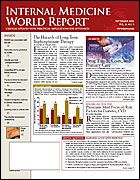Publication
Article
Internal Medicine World Report
Insight Into the Future Treatment of hcv
Author(s):
Gastroenterology
An estimated 3.25 million Americans are chronically infected with hepatitis C virus (HCV), including 250,000 incarcerated men and women. Most are under the age of 50, do not have symptoms, and have not yet been diagnosed. Results of a new study (. 2006; 131:478-484) offer a glimpse into the characteristics of future patients and what treatment they will require. HCV is now the major cause of chronic liver disease in the United States.
The type of treatment for chronic HCV infection as well as the response to it depend on disease- and patient-related characteristics. Persons infected with HCV genotype 2 or 3 typically need only 6 months of treatment to achieve a sustained virologic response, whereas those infected with genotype 1 require 12 months of treatment.
Patients infected with HCV genotype 1 are far less likely to achieve a sustained virologic response than those infected with HCV genotype 2 or 3. A sustained response is much less likely to occur in blacks than in whites, regardless of HCV genotype.
Because most data on chronic HCV infection have come from clinical trials studying HCV treatment, the investigators focused on a cohort of patients from the general population rather than those recruited from a clinical care setting or those who fulfilled eligibility requirements for a treatment trial.
They examined data from the Third National Health and Nutrition Examination Survey (1988-1994) and identified 364 anti—HCV-positive participants whose specimens were available for RNA testing. Of these, 284 samples were HCV RNA positive and were found suitable for further analysis.
Weighted analysis revealed that genotype 1 accounted for 75.3% of all infections. Among the remaining samples, genotype 2 was twice as prevalent as genotype 3 (16.3% vs 8.5%).
P
When broken down by age and gender, genotype 1 was the culprit in 75.9% of those aged <50 years, 78.4% of men, and 68.8% of women ( >.05 for comparisons by age-groups or gender). By ethnicity, non-Hispanic blacks were significantly more likely to be infected with genotype 1 than non-Hispanic whites or Mexican Americans (90.9% vs 69.6%, vs 71.2%, respectively).
On multivariate analysis, race/ethnicity emerged as the only characteristic that was independently associated with genotype 1 infection. This genotype was 5 times more likely to be responsible for chronic HCV infection in blacks than in whites.
Although evidence suggests that younger age at infection may result in improved long-term outcomes, Omana V. Nainan, PhD, of the Centers for Disease Control and Prevention, and the University of Texas Medical Branch at Galveston, and colleagues write, “Younger persons are primarily infected with genotype 1, blacks are disproportionately represented among persons with this genotype, and there is no indication that non-1 genotypes are emerging.”
They conclude, “Thus, although the severe complications of HCV infection may be less likely to develop in younger persons, the characteristics of this population make them more difficult to treat.” They emphasize the need for improved therapies for genotype 1 infections and for counseling and immunization to decrease these future patients’ risk for additional liver injury from alcohol abuse and from other viral infections





